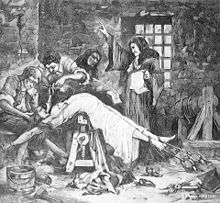Madame de Brinvilliers


Marie-Madeleine-Marguerite d'Aubray, Marquise de Brinvilliers (22 July 1630 – 17 July 1676) was a French aristocrat accused of three murders. She was convicted on the strength of letters written by her dead lover and a confession obtained by torture, so her guilt remains uncertain.
Crimes
According to the charges laid against her in 1675, in 1666 Marie-Madeleine-Marguerite de Brinvilliers had conspired with her lover, Captain Godin de Sainte-Croix, also called the Chevalier de Sainte Croix, to poison her father Antoine Dreux d'Aubray, and in 1670 she had likewise killed two of her brothers, Antoine and François d'Aubray, in order to inherit their estates. Her alleged accomplice Sainte-Croix had died of natural causes in 1672, so could not be charged. There were also rumours that Brinvilliers had poisoned poor people during her visits to hospitals, but she was not charged with any such killings.[1]
The charges against Brinvilliers originated from diaries and letters found in the possession of Sainte Croix after his death, contained in a red leather box which he had marked as not to be opened until after the death of Brinvilliers. She was accused of using Tofana poison and was reported to have learned how to make it from Sainte Croix, who had himself learned the method from Exili, an Italian poisoner who had been his cellmate in the Bastille.[1]
In 1675, on being accused, Brinvilliers fled to England, the Netherlands, and finally a convent near Liège, where she was arrested by a policeman pretending to be a priest. On 17 July 1676, she was tortured with the water cure, that is, made to drink sixteen pints of water (more than 9 litres) and forced to confess. On the strength of the documents left behind by Sainte Croix and her own confession she was sentenced to death, despite the objections of her defence counsel that there was no good evidence for her guilt.[1] She was then beheaded, and her body was burned at the stake.
Her trial and the scandal which followed it launched the Affair of the Poisons, which saw several French aristocrats charged with witchcraft and poisoning.
Fictional portrayals
Fictional accccounts of her life include The Leather Funnel by Arthur Conan Doyle, The Marquise de Brinvilliers by Alexandre Dumas, père,[2] The Devil's Marchioness by William Fifield, and Intrigues of a Poisoner by Émile Gaboriau.[3] Robert Browning's 1846 poem "The Laboratory" imagines an incident in her life. Her capture and burning is mentioned in The Oracle Glass by Judith Merkle Riley, also the poisoning of the poor is echoed by the main character, Genevieve's, mother. The plot of the novel The Burning Court by John Dickson Carr concerns a murder that appears to be the work of the ghost of Marie d'Aubray Brinvilliers.
There have been two musical treatments of her life. An opera titled La marquise de Brinvilliers with music by nine composers—Daniel Auber, Désiré-Alexandre Batton, Henri Montan Berton, Giuseppe Marco Maria Felice Blangini, François-Adrien Boieldieu, Michele Carafa, Luigi Cherubini, Ferdinand Hérold, and Ferdinando Paer—premiered at the Paris Opéra-Comique in 1831.[4] A musical comedy called "Mimi - A Poisoner's Comedy" written by Allen Cole, Melody A. Johnson, and Rick Roberts premiered in Toronto, Canada in September 2009.[5]
The Sailor Moon musical Kessen / Transylvania no Mori (Kaiteiban), included a character known as De Brinvilliers-sensei. She was a vampire who posed as a chemistry teacher who tested her students about various poisons.
Margarita Blankenheim, a character based on the Vocaloid Hatsune Miku, was based after the woman. A song sung by Hatsune Miku known as "Gift from the Princess who Brought Sleep" describes Margarita's actions.
References
- 1 2 3 Chisholm 1911.
- ↑ "The Marquise de Brinvilliers"
- ↑ "Gaboriau's sensational novels". google.com.
- ↑ Musical Times: "The Material of Music," April 1, 1888, 209, accessed May 10, 2010
- ↑ Toronto Star: Richard Ouzounian, "Mimi is wickedly, deadly delicious," September 24, 2009, accessed May 10, 2010
- Attribution
-
 Chisholm, Hugh, ed. (1911). "Brinvilliers, Marie Madeleine Marguerite d'Aubray, Marquise de". Encyclopædia Britannica. 4 (11th ed.). Cambridge University Press. p. 572.
Chisholm, Hugh, ed. (1911). "Brinvilliers, Marie Madeleine Marguerite d'Aubray, Marquise de". Encyclopædia Britannica. 4 (11th ed.). Cambridge University Press. p. 572.
External links
-
 Wood, James, ed. (1907). "Brinvilliers, Marquise de". The Nuttall Encyclopædia. London and New York: Frederick Warne.
Wood, James, ed. (1907). "Brinvilliers, Marquise de". The Nuttall Encyclopædia. London and New York: Frederick Warne. - Anne Somerset - The Affair of the Poisons: Murder, Infanticide, and Satanism at the Court of Louis XIV (St. Martin's Press (October 12, 2003) ISBN 0-312-33017-0)